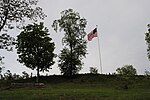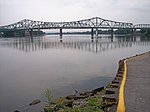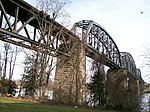Little Kanawha River
Allegheny PlateauLittle Kanawha RiverRivers of Braxton County, West VirginiaRivers of Calhoun County, West VirginiaRivers of Gilmer County, West Virginia ... and 7 more
Rivers of Lewis County, West VirginiaRivers of Upshur County, West VirginiaRivers of West VirginiaRivers of Wirt County, West VirginiaRivers of Wood County, West VirginiaTributaries of the Ohio RiverWest Virginia placenames of Native American origin

The Little Kanawha River is a tributary of the Ohio River, 169 mi (269 km) long, in western West Virginia in the United States. Via the Ohio, it is part of the watershed of the Mississippi River, draining an area of 2,320 mi2 (6,009 km2) on the unglaciated portion of the Allegheny Plateau. It served as an important commercial water route in the early history of West Virginia, particularly in the logging and petroleum industries.
Excerpt from the Wikipedia article Little Kanawha River (License: CC BY-SA 3.0, Authors, Images).Little Kanawha River
Milton Street,
Geographical coordinates (GPS) Address Nearby Places Show on map
Geographical coordinates (GPS)
| Latitude | Longitude |
|---|---|
| N 39.26535 ° | E -81.56901 ° |
Address
Milton Street
26101
West Virginia, United States
Open on Google Maps











